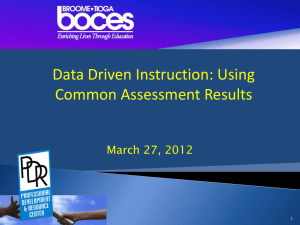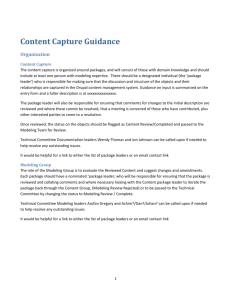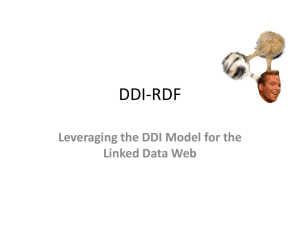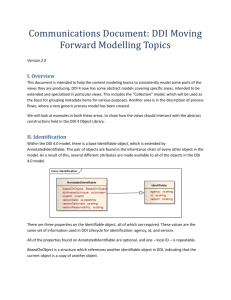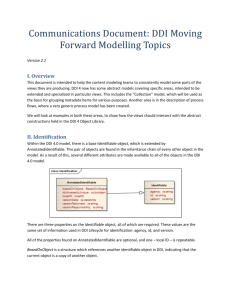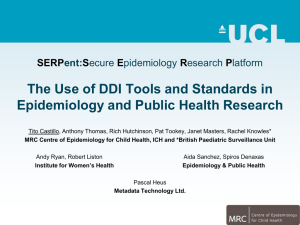Slides
advertisement
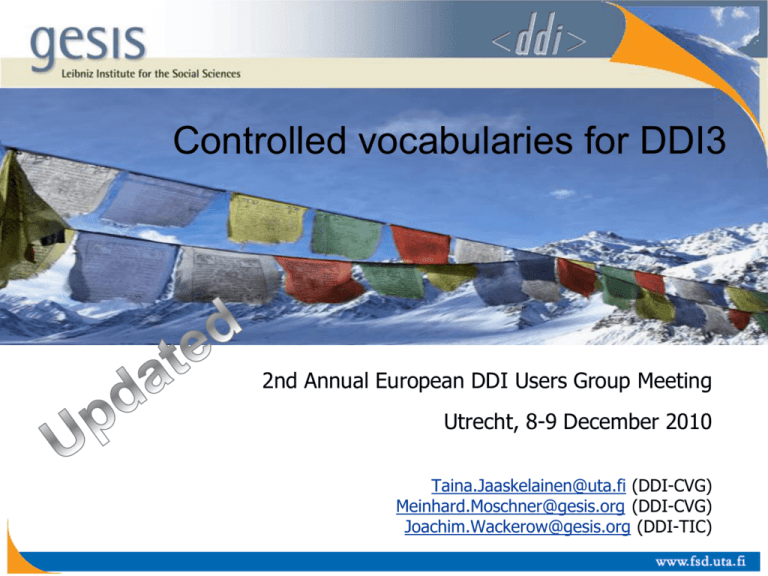
Controlled vocabularies for DDI3 2nd Annual European DDI Users Group Meeting Utrecht, 8-9 December 2010 Taina.Jaaskelainen@uta.fi (DDI-CVG) Meinhard.Moschner@gesis.org (DDI-CVG) Joachim.Wackerow@gesis.org (DDI-TIC) Controlled vocabularies • • • • • • Organized list of subject terms for indexing and retrieval (Ideally) exhaustive list of terms Mutual exclusive terms (no overlapping) Clearly defined subject terms The only choice for usage in a specific context Scope notes to avoid misunderstanding if needed • From a short flat list to a hierarchical thesaurus, including relationships between terms (e.g. ELSST) • As comprehensive and complex as necessary, but as simple as possible! Importance of CVs • Optimizing indexing and searching • • • • • Language control (synonyms and lexical anomalies) Consistency and efficiency in the production of metadata Semantic/technical interoperability between organizations Semantic/technical interoperability between systems Precision of data retrieval • CVs usually do not replace textual description! CVs and DDI3 (1) Code values for computer processing & human readable descriptions • Metadata formats: – machine readable (structured or semi-structured text) free text search, e-documents – machine interpretable (DDI2) field search, interface independent, exchange format – machine actionable (DDI3) supported search, multilinguality, access control, interactivity Supporting a search application… ...further application examples • Multilingual access and documentation – translation of CVs – ISO 639 language codes • Authentication and authorisation procedures – ISO country codes country of data / end user origin – ... • ... • Temporal, spatial and topical comparability – concept (e.g. ELSST) + universe + geographical coverage – time method, sampling, mode of data collection, ... CVs and DDI3 (2) • Embedded controlled vocabularies (very general and relative static) logical operators, … • Well-established external vocabularies ISO country code, ISO language code, … • CVs for DDI3 and other metadata structures! – Publication forthcoming 1/2011 – currently under revision – still to be developed (e.g. for qualitative data types) Available CVs in 1/2011 • LifeCycleEvent /EventType DDI3.1: reusable.xsd • AnalysisUnit DDI3.1: reusable.xsd; DDI2: 2.2.3.8 anlyUnit & 4.3.7 var:/nCube: anlysUnit • SoftwarePackage DDI3.1: reusable.xsd; DDI2: 3.1.11 • TimeMethod see example! DDI3.1: datacollection.xsd; DDI2: 2.3.1.1 • ModeOfDataCollection close to be fished! DDI3.1: datacollection.xsd; DDI2: 2.3.1.6 Available CVs as of 12/2010 • ResponseUnit for survey type data! DDI3.1: datacollection.xsd; DDI2: 4.3.6 • CommonalityType DDI3.1: comparative.xsd • SummaryStatistic DDI3.1: physicalinstance.xsd; DDI2: 4.3.14 • CategoryStatistic close to be fished! DDI3.1: physicalinstance.xsd; DDI2: 4.3.17.2 • CharacterSet DDI3.1: physicaldataproduct.xsd; DDI2: 3.1.5 Publication • DDI CVs are a separate product from the DDI Alliance • Published independently from the DDI XML Schemas – Intended for the usage with DDI, but can be used by other systems as well – Creative Commons License • Expressed in a tabular model: – – – – columns define type of data (= meta data) in the code list rows define actual values (= meta data) in the code list code + term + conceptual description/definition + translations entry tool as Excel spreadsheet, readable visualization as HTML • Genericode is a generic format for code lists – XML standard from OASIS (Organization for the Advancement of Structured Information Standards) • Name and version number – Version structure can have major, minor, and sub-minor version Example: TimeMethod DDI3: datacollection.xsd / DDI2: 2.3.1.1 (Study Description Data Collection Methodology) • Longitudinal – – – – – Longitudinal.CohortEventBased Longitudinal.TrendRepeatedCrossSection Longitudinal.Panel Longitudinal.Panel.Continuous Longitudinal.Panel.Interval • TimeSeries – TimeSeries.Continuous – TimeSeries.Discrete • CrossSectional – CrossSectionalAdHocFollowUp • Other Example: TimeMethod Genericode Example DDI_3.1_Part_I_Overview.pdf Appendix 5 <?xml version="1.0" encoding="UTF-8"?> <gc:CodeList xmlns:xsi="http://www.w3.org/2001/XMLSchema-instance" xmlns:gc="http://docs.oasis-open.org/codelist/ns/genericode/1.0/" xmlns:xhtml="http://www.w3.org/1999/xhtml" xsi:schemaLocation="http://docs.oasis-open.org/codelist/ns/genericode/1.0/ http://docs.oasisopen.org/codelist/cs-genericode-1.0/xsd/genericode.xsd"> … <xhtml:p class="ModuleName">datacollection</xhtml:p> <xhtml:p class="Title">Time Method</xhtml:p> <xhtml:p class="XPath">/n1:DDIInstance/s:StudyUnit/d:DataCollection/d:Methodology/d:TimeMethod</xhtml:p> <xhtml:p class="Description">Controlled vocabulary for time method</xhtml:p> … <LocationUri>http://www.ddialliance.org/ControlledVocabularies/TimeMethod_gc.xml</LocationUri> <Agency> <LongName>DDI Alliance</LongName> </Agency> … <Row> <Value ColumnRef="Code„> <SimpleValue>Longitudinal.RepeatedCrossSection </SimpleValue> </Value> <Value ColumnRef="ParentCode"> <SimpleValue>Longitudinal </SimpleValue> </Value> <Value ColumnRef="LevelSpecificCode„> <SimpleValue>RepeatedCrossSection </SimpleValue></Value> </Row> … <Row> <Value ColumnRef="Code"> <SimpleValue>Longitudinal.Panel< /SimpleValue></Value> </Row> … </Row> </SimpleCodeList> </gc:CodeList> … can be referenced and processed by software applications! http://www.oasis-open.org Management and Maintenance • DDI Controlled Vocabularies Group (DDI-CVG) • Forthcoming implementation experiences – different data holdings (heterogeneity of DDI user community) – review of ”other” entries (missing terms) – institution specific revisions and/or extensions • Current focus on the quantitative data type • Institutionalisation of the CESSDA research infrastructure – mandatory or recommended use of controlled vocabularies – translation of definitions to respective local languages (unclear definitions?) – migration from DDI2 to DDI3 Acknowledgements • DDI Controlled Vocabularies Group (CVG): • DDI Technical Implementation Committee (TIC) • Review participants at ... – – – – – – – – – Atle Alvheim, NSD, Bergen Sanda Ionescu (chair) , ICPSR, Ann Arbor MI Taina Jääskeläinen, FSD, Tampere Chryssa Kappi, EKKE, Athens Fredy Kuhn, FORS, Lausanne Ken Miller, UK-DA , Essex (retired) Meinhard Moschner, GESIS, Cologne Pascal Heus (ODaF), Wendy Thomas (MPC), Achim Wackerow (GESIS), ... ABS (AU), ADP (SI), CentERdata (NL), DDA (DK), FSD (FI), GESIS (DE), ICPSR (US), SND (SE), UK-DA (GB), ... Resources and contact • Controlled Vocabularies on the DDI Alliance website: http://www.ddialliance.org/controlled-vocabularies • CVG Contact: ddi-cvg@ddialliance.org sandai@umich.edu • IASSIST Quarterly Spring-Summer 2009 http://www.iassistdata.org/iq/issue/33/1
